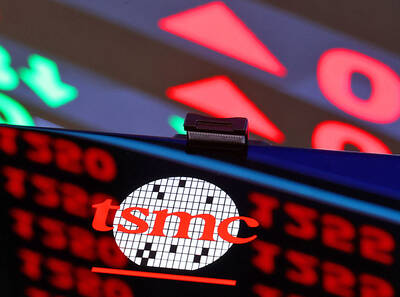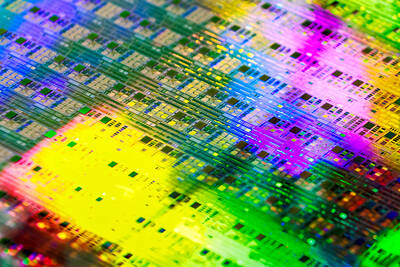“Smartbook” is the latest buzzword in the PC world, but exactly how well consumers are warming up to this new breed of laptop computer and whether it could become a new notebook segment remains to be seen, industry pundits said.
“The smartbook sector now is still in a blur,” Acer Inc (宏碁) product manager Sean Chang (張碩修) said in a recent interview.
Smartbooks are using a completely different platform from the Wintel (Windows-Intel) standard, so there are thresholds to overcome before Acer can move into the smartbook foray, Chang said.

PHOTO: AFP
“This involves a drastic change in the Wintel platform and it remains to be seen how well consumers will embrace it,” he said.
With screen sizes of between 5 inches and 10 inches, smartbooks aim to bridge the gap between smartphones and netbooks. Smartbooks are designed to be always on, just like smartphones, and connected to the Internet via third-generation (3G) telecom networks.
This way, e-mail is more likely to arrive automatically on smartbooks rather than requiring users to log on to the Internet to fetch messages. Also, checking out movie times, weather forecasts and posting to Facebook can be done in a matter of seconds.
Unlike netbooks and most standard laptops, smartbooks are not based on x86 microprocessors from Intel Corp or Advanced Micro Devices Inc, or the popular Windows operating system from Microsoft Corp.
The supporters of smartbooks are handset chipmakers making their first attempts in the laptop market. These players include Nvidia Corp, Qualcomm Inc, Freescale Semiconductor Inc and Marvell Technology Group Ltd, which license microprocessor designs from ARM Holdings PLC and combine it with their own technologies.
Taiwanese networking chipmaker Realtek Semiconductor Corp (瑞昱半導體) gives a thumbs-up to smartbooks.
“Smartbooks may eat into netbooks’ share,” said Amanda Lee (李文婷), Realtek’s project manager for marketing and planning.
This is because smartbooks sport a horde of easy-to-use interfaces and low-cost operating system, which could lure certain consumer segments, she said.
Dickie Chang (張祐菖), a PC solutions analyst at International Data Corp (IDC) Taiwan, disagrees.
When Asustek Computer Inc (華碩電腦) introduced the market’s first netbooks in late 2007 with only a seven-inch screen and a Linux operating system, people shied away from them despite the cheap price tag of US$400, he said.
If smartbooks are introduced in the same form and run on a non-Windows platform, there would be an interface gap for users, Chang said.
However, netbooks started to win over consumers with their low price tags, but gained more fans with Windows, bigger screens and hard disk drives.
In the third quarter of last year, netbooks accounted for 28 percent of all notebook shipments, doubling its share from a year ago, an IDC report released in December showed.
Netbooks are set to continue growth momentum this year, but at a slower rate, as the introduction of new ultra-thin portables will generate new growth points and limit the share captured by netbooks, the research house said, without identifying the types of ultra-thin portables.
Late last month, Apple Inc launched the iPad tablet computer — a thin and light, 9.7-inch touchscreen device good for Web browsing, video, games and electronic books, at US$499 each. Apple is positioning the iPad as a “third category” device — somewhere between laptops and smartphones — but demand is still uncertain.
Meanwhile, Hewlett-Packard (HP) Co showed off a similar product, dubbed the HP Slate, at the 2010 Consumer Electronics Show (CES) in Las Vegas last month. While exact specifications are unknown, it is a touchscreen model running on Windows 7.
At the same show, Lenovo Group Ltd (聯想) took the wraps off its first smartbook — Skylight. It runs on Qualcomm’s Snapdragon chip and Linux.
It boasts more than 10 hours of active battery life and has built-in Wi-Fi and 3G connectivity for constantly “on” net surfing. It will sell for US$499 in the US from April, and will be available in Europe and China later this year.
Asustek product manager Jose Liao (廖逸翔) said of smartbook uptake: “It depends on how they can offer what users really want.”
“If a smartbook’s only purpose is Internet surfing, will it gain momentum even if its prices are super cheap?” Liao asked, saying that some netbooks already sell at an affordable NT$10,000 — not to mention they already have proven features and more makers are dedicating resources to their development.
Not joining the smartbook chase for now, both Acer and Asustek said they are focusing on netbooks, ultra-low voltage models and standard notebooks, and would throw in 3D and touchscreen features to spice laptop appeal.
“Every maker now wants to grab a slice of the pie,” Acer’s Chang said. “But we will wait and see what kind of smartbooks or tablets hit the market and what applications are available to the computer users before considering jumping onto the production line.”

SEMICONDUCTOR SERVICES: A company executive said that Taiwanese firms must think about how to participate in global supply chains and lift their competitiveness Taiwan Semiconductor Manufacturing Co (TSMC, 台積電) yesterday said it expects to launch its first multifunctional service center in Pingtung County in the middle of 2027, in a bid to foster a resilient high-tech facility construction ecosystem. TSMC broached the idea of creating a center two or three years ago when it started building new manufacturing capacity in the US and Japan, the company said. The center, dubbed an “ecosystem park,” would assist local manufacturing facility construction partners to upgrade their capabilities and secure more deals from other global chipmakers such as Intel Corp, Micron Technology Inc and Infineon Technologies AG, TSMC said. It

EXPORT GROWTH: The AI boom has shortened chip cycles to just one year, putting pressure on chipmakers to accelerate development and expand packaging capacity Developing a localized supply chain for advanced packaging equipment is critical for keeping pace with customers’ increasingly shrinking time-to-market cycles for new artificial intelligence (AI) chips, Taiwan Semiconductor Manufacturing Co (TSMC, 台積電) said yesterday. Spurred on by the AI revolution, customers are accelerating product upgrades to nearly every year, compared with the two to three-year development cadence in the past, TSMC vice president of advanced packaging technology and service Jun He (何軍) said at a 3D IC Global Summit organized by SEMI in Taipei. These shortened cycles put heavy pressure on chipmakers, as the entire process — from chip design to mass

People walk past advertising for a Syensqo chip at the Semicon Taiwan exhibition in Taipei yesterday.

NO BREAKTHROUGH? More substantial ‘deliverables,’ such as tariff reductions, would likely be saved for a meeting between Trump and Xi later this year, a trade expert said China launched two probes targeting the US semiconductor sector on Saturday ahead of talks between the two nations in Spain this week on trade, national security and the ownership of social media platform TikTok. China’s Ministry of Commerce announced an anti-dumping investigation into certain analog integrated circuits (ICs) imported from the US. The investigation is to target some commodity interface ICs and gate driver ICs, which are commonly made by US companies such as Texas Instruments Inc and ON Semiconductor Corp. The ministry also announced an anti-discrimination probe into US measures against China’s chip sector. US measures such as export curbs and tariffs